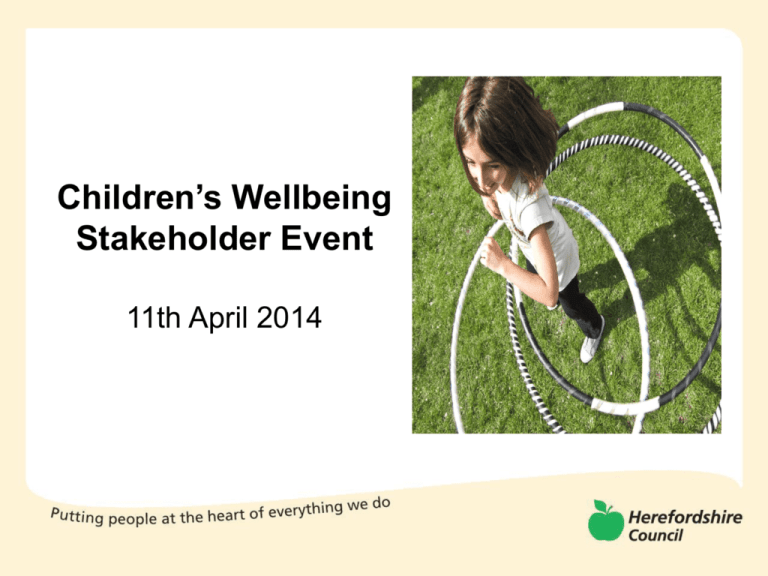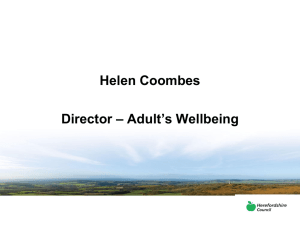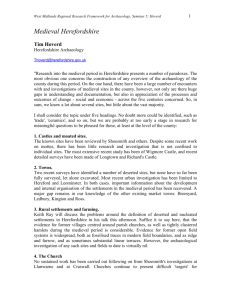Tots to Teens Investing in our Future
advertisement

Children’s Wellbeing Stakeholder Event 11th April 2014 Introduction and Housekeeping Jo Davidson: Director of Children’s Wellbeing Access to Information and Advice for Families and Professionals Les Knight: Head of Additional Needs Family Information Service – a single point of information Family information directory Our family information directory helps parents, carers and professionals find useful local services. It comes in three parts: To find services for families, visit the family service directory To find both registered and unregistered local childcare providers, visit the childcare directory To find information about services for children with special educational and other needs, visit the Herefordshire local offer pages Documents Positive Activities Bromyard Area - 103kb Positive Activities in Leominster and Wigmore Area - 192kb Positive Activities in Ledbury Area - 8kb Related pages Schools directory Family Services Directory and Childcare Directory Alphabetical lists of Providers Searchable Directory Favourites/Basket Function Click on individual entries – Contact details and what they offer Changes to the SEN system – Children and Families Act 2014 • Age range - birth to 25 • Provide children, young people and their parents greater control and choice in decisions • Replace Statements of SEN and s139a Learning Difficulty Assessments with a 0 to 25 Education, Health and Care Plan (EHC Plan) -Focus on outcomes • Offering families personal budgets for all key agencies • Closer multi-agency/partnership working in particular requiring LA and health authorities to work together. • Local Offer The Local Offer • Information for families and practitioners – ‘clear, comprehensive and accessible’ • ‘Responsive to local need’ with families involved in development and review - duty is to consult • Not just a directory • How to access services (‘transparency’) as well as description of provision • Must include education (incl. schools), health and social care – ‘must co-operate’ • Working with the web team - Interactive feedback • Keeping it up-to-date! The Local Offer – Not A Directory Prepared for SE7 by Sharon Smith Hampshire Parent/Carer Network They often receive conflicting advice and simply do not know who to trust to give them the information that will help them… Parents report that they tend to only trust other parents’ advice who have already been through the system and understand which direction to go in. The Local Offer – Not A Directory The Local Offer has to deliver: Prepared for SE7 by Sharon Smith Hampshire Parent/Carer Network A one-stop shop for parent carers to access all of the information that they will need relating to their child/young person – so that parents know exactly where to go every time that they need help or information. The Local Offer A local authority must publish information about: The provision it expects to be available in its area at the time of publication for children and young people who have special educational needs, and… The provision it expects to be available outside its area at that time for children and young people for whom it is responsible. The Local Offer The provision referred to is: a) b) c) d) education, health and care provision; other educational provision; training provision; arrangements for travel to and from schools and post-16 institutions and places at which relevant early years education is provided; e) provision to assist in preparing children and young people for adulthood and independent living. The Local Offer A local authority must keep its local offer under review and may from time to time revise it. It must also publish comments received and its responses to the comments Herefordshire Local Offer for SEN, Disability and other Additional Needs Welcome to Herefordshire’s Local Offer! This is intended to be a ‘one-stop shop’ that allows parents, carers, family members and practitioners working with families to find the information they want. At the present time, the development of the Local Offer web pages are at a relatively early stage of development and the information available will grow over the next few months. The aim is that it will be quick to find the information that you want and that the information is presented in a clear and understandable fashion. To help us to do this, please use this feedback link to tell us if you have not been able to find what you want or if the information is confusing or out of date. You will find that each of the pages of the local offer also have a feedback facility. If you want more detail about how the Local Offer should work, please follow this link…local offer. This link also provides information on the Children and Families Act 2014 which requires Local Authorities to create the Local Offer. If you just want to get on with using the information, click on one of the sections below. Top Tasks – What do you want to know? How do I get a statement for my child? Can I get an education, health and care plan (EHCP) for my child? Will I be entitled to transport to school if they have a disability? What do I need to do if my child is diagnosed with a disability? Where can I get respite from my caring duties? How do I get financial support for my child? Do I need a social worker? Main Sections Education Services Moving to Independence Health Services Education, Health and Care Plans Social Care Services including Short Break/Respite Service Voluntary Organisations and other sources of help How do I get financial support for my child? Education Social care Health Other sources of financial support What if my son or daughter needs more support than the school can provide? Additional funding until July 2014 For children with statements, including pupils in special schools, the additional funding is described in the statement which is reviewed at least annually. Parents and carers are invited to every annual review. The funding is at one of two levels described in the next paragraph. This funding is provided into the budget of mainstream schools at the start of the financial year. If the school feels that a higher level of funding is required, the school can apply for ‘banded funding’. The school brings the evidence to a panel made up of school and local authority representatives experienced in SEN. The panel can agree one of three outcomes: band 3 £1350; band 4 £5,500; or, that the evidence does not support the allocation of additional funding. Education - local offer What do our Educational Settings Offer? • • • • Early Years Settings Schools Post-16 Education and Training Providers Special Schools and Other Specialist/Alternative Provision My Child has a difficulty with…? Different Barriers to Learning • • • • • • autism and other complex communication difficulties behavioural, emotional and social difficulties language and communication hearing and visual impairment learning difficulty physical and medical Voluntary and support services - local offer Voluntary and support services Hereford Carer Support For information visit the HCS website Marches Family Network For information visit the MFN website Parent partnership service For information visit the parent partnership service page Link to regional information Link to national directory of voluntary organisations SENDirect e-brokerage system– Herefordshire Pilot Site • • • • • • • • Consortium of 8 leading national charities One of 10 LAs nationally to win bid to pilot Will be part of Local Offer Aims to link Parents and Providers Funded by the DoH and DfE Currently developing software Planned launch in March 2015. Need parents and providers to sign up to test it SENDirect website www.sendirect.org.uk Herefordshire Children’s Integrated Needs Assessment INTERIM FINDINGS Leonie Roberts Interim Consultant in Public Health Needs Assessment Demographics Health Education Safeguarding Services Key themes Demographics 39,900 children and young people Notable drop at 19 – University Expected population changes Migration is the key driver of demographic change 1800 to 1900 live births per year Number of births to UK women remained constant (1600 per year) Increase in number of births from EU (150 in 2012) Young adults (18-25 are the most mobile Net out-migration of young adults (18-25) Dampened by increased migration from overseas Smoking Substance misuse Sexual activity Alcohol Mental Health and Well-being HEALTH THROUGH THE LIFE COURSE Health and wellbeing Early years (0-4 years) Infant mortality rate per 1000 live births was 3.9 for the period 2009-2011 (4.4 England average) Low birth weight varies by practice 5.7% to 8.8% (County average 7.4%) Smoking rate at time of delivery 11.2 per 100 maternities (13.2 England average) Breastfeeding initiation rate of 73% (64% national) Immunisation The county is not meeting the 95% coverage needed to protect the most vulnerable children 100.0 95.0 ENGLAND 90.0 WEST MIDLANDS 85.0 COMPARATOR GRP 80.0 Herefordshire PCT 75.0 70.0 DTaP/IPV/Hib prim MenC prim MMR1 Hib/MenC booster PCV booster Health and wellbeing Age 5 to 19 58 deaths between 2002 and 2011. Traffic accidents were the most common cause Teenage conceptions 26.0 per 1000 girls aged 15-17. (30.7 per 1000 England) 44.4% of 12 year-olds had evidence of dental decay (33.4% in England) Obesity among year 6 pupils varies from 9.7% to 25.7% (16.5% county average, 19% national) Hospital admissions 3500 3000 0-4 2500 5-9 2000 10-14 1500 15-19 1000 500 0 2008/09 2009/10 2010/11 2011/12 2012/13 25000 20000 DSR per 100,000 population 15000 10000 5000 0 DSR Q1 least deprived Q2 Q3 Q4 most deprived County 16603.7 18333.3 16089.6 23188.7 18801.2 Most common hospital admissions Age 0-4 Viral and acute respiratory admissions Age 5-14 Respite care (35%) Age 15-19 Respite care(25%) and pregnancy related (15%) 850 respiratory admissions age 0-19. 40% from the most deprived areas. Alcohol Attributable admissions to hospitals 160 140 120 100 80 60 40 20 0 Males Females Persons Education population 21,700 children attending state-maintained schools: 12,700 at primary level and 8,900 at secondary Actual and forecast pupils in Herefordshire schools (compared to resident population) 16,000 14,000 12,000 Number 10,000 8,000 6,000 4,000 2,000 Primary school pupils Residents aged 4 to 10 Secondary school pupils Residents aged 11 to 15 - Year Education Total Number of English as an Additional Language pupils 1,400 1,200 1,000 800 600 400 200 0 Spring 2011 Summer 2011 Autumn 2011 Spring 2012 Summer 2012 Autumn 2012 Spring 2013 Summer 2013 Autumn 2013 Educational development Age 22 months to 10 years SES – Social economic status Q– Cognitive score Educational attainment Early years – above the national average Key stage 1 – same as national average Key stage 2 – 71% below national average Early years – Free school meals below the national average Key Stage 1 – FSM slightly below national average Key stage 2 49% FSM, 20% LAC “The difficulty of doing GCSEs when you’re coping with homelessness and just trying to survive” Young person in Hereford Percentage of Pupils Achieving 5+ A* - C including English and Maths 80.00% 70.00% 60.00% 50.00% 40.00% 30.00% 20.00% 10.00% 0.00% Herefordshire England Post 16 Qualifications Percentage of students achieving at least 2 substantial Level 3 qualifications against Statistical Neighbours 98.00% 96.00% 94.00% 92.00% 90.00% 88.00% 86.00% 84.00% 82.00% Safeguarding and social care for vulnerable children and young people 39,900 1604 216 239 Vulnerable Children Defining vulnerabilities is difficult - Children who are at risk of, or who are already experiencing, social and emotional problems. Vulnerability may be linked to disadvantage and poverty Young carers Gypsy and travellers Children experiencing domestic violence and abuse Homeless Mental health issues Young offenders Looked after children Disabled children Vulnerable children 1400 children claiming disability living allowance 311 children and young people on the carers register. Only 11% of carers are on the register 255 Gypsy and Roma children and young people known to the Council 113 people aged 10-17 entered the youth justice system for the first time. (2012/13) This equates to 671 first time entrants per 100,000 youth population. This is higher than the West Mercia rate of 546 per 100,000 Homeless 5 4.5 No. per 1000 h/holds 4 3.5 3 2.5 2 1.5 1 0.5 0 Herefordshire has a high rate of homelessness this means that more children compared to the national and statistical neighbours’ average will become homeless Over half of households labelled homeless have dependent children equating to 201 children Children in need Child who is unlikely to have, or have the opportunity to have a reasonable standard of health and development without any support provided by a public authority 1139 children in need (excluding LAC, CPP) 1800 1600 1400 Herefordshire’s rate of children at 445.5 per 1000 children is higher than national (325.7)and statistical neighbours (301.5) 1200 1000 800 600 400 200 0 Jun- 2009 Jun-2010 Jun-2011 Jun-2012 Jun- 2013 Type of abuse for Children in Need Children in need 2013 50.0% 45.0% 18% NOT RECORDED 40.0% 35.0% 30.0% 25.0% 20.0% National 15.0% 10.0% 5.0% 0.0% Herefordshire Statistical Neighbours Looked after children A looked after child (LAC) is a child who is accommodated by the local authority either as a result of voluntary agreement by their parents or as a result of a Care Order issued by a court of law to safeguard the child 241 LAC in Herefordshire 67 LAC per 10,000 in December 2013 47 per 10,000 statistical neighbours 250 200 150 100 50 0 Jun2009 Jun-2010 Jun-2011 Jun-2012 Jun2013 Looked after children Types of Abuse/Neglect Recorded for LAC 40 35 30 25 20 15 10 5 0 Not Specified Neglect Domestic Abuse Physical Abuse Emotional Abuse Other Unrecorded Sexual Abuse Child or young person as abuser Children with child protection plans 90 80 70 60 50 Rate of Children becoming the subject of a CPP through out 2012-2013 40 30 20 Rate of Children being on CPP at the end of 31 March 2013 10 0 239 children with CPP in June 2013 (an increase of 36% since June 2012) Children exposed to domestic violence Source Maximum number of children in Q4 Q1 Q2 Q3 2012-13 2013-14 2013-14 2013-14 WMWA 145 151 119 138 WMP 429 454 513 501 WMP 10 21 13 29 65 47 58 55 WMWA Number of children exposed to domestic abuse crimes and incidents Children Exposed to DA three or more times Number of children involved in MARAC cases What are the main issues facing vulnerable children and young people in Herefordshire? The main issues are: Poor parenting Funding / service & budget cuts Rural isolation & rural service issues Lack of support to address needs Lack of early intervention What support do children and young people think they need? • SUPPORT WORKERS - long-term, consistent and skilled support • MENTORING – support from others who have been through similar situations • SUPPORT PLANS – help practically and emotionally through adverse life events and transitions • POSITIVE INTERVENTIONS – targeted support • SAFE, WARM, AND SOCIAL ENVIRONMENTS • EMOTIONAL SUPPORT “I’ve known people who are struggling, thin and • PRACTICAL SUPPORT underweight. You can’t bear to look at them. They • AVOID CRISIS INTERVENTION THAT PUTS YOU have no strength left in AT INCREASED RISK them. The Herefordshire system is not working for anybody” What support do organisations think children and young people need? Early holistic intervention Consistent support from key workers Improve the ability of schools to support issues Greater focus on holistic family support and family assessments Parental support and education “We need to offer consistent and early intervention to prevent escalation and families having to enter crisis situations before help is provided.” Statutory Sector Representative How are services addressing the needs? The responsibilities for preventing vulnerable children and young people from becoming ’in need’ or looked after are shared between a relatively small, and ever decreasing, number of statutory, voluntary and private sector services The size and scale of the voluntary sector working with children and young people generally in Herefordshire appears to be small in comparison with other counties. Expect 150 organisations to be working children and young people. Only identified 30. The Local Authority LAC team do a good job engaging young people and supporting schools Headteacher “It’s warm, interesting people, nice workers. If it wasn’t here crime would go up a bit. Here you make more friends, youth workers communicate with you, they teach you stuff…helpers…if there’s stuff going on at home they are “ Young people have such a turn-over here for us. They of workers, rather like the chaos in their teach you life skills.” lives. “ Headteacher Young person “You have to accept that there is no attending a youth money, but when you are rock bottom club that’s not good enough.” “Would like to see children supported at an earlier opportunity, rather than waiting until the risks become so great” What are the best things that are happening in Herefordshire? Figure 2: Survey respondents perceptions of best things happening to address risk factors 7% 13.5% 17% 19% 34% (4 respondents) (8 respondents) (10 respondents) (11 respondents) (20 respondents) Working more effectively with schools Desire to improve services & provider communication Co-ordinated interventions CAF system and collaboration Effective work with families & troubled family programme MASH and multiagency working / collaboration “The MAG is very good for sharing information and signposting children for the necessary support, although due to the ever reducing services this can take quite a long time…” Voluntary Sector Representative 3 examples of Herefordshire working at it’s best: • Using the Solihull approach to support and develop foster carers • Building a community based youth service • Testimonies from CYP to the importance of good practitioners of social care How do respondents rate the effectiveness of support? Survey respondents rating of the effectiveness of the support children and young people get Not very good Quite good Good Very good 31% 51% 15% 1.5% Text analysis of the 50+ survey comments on the effectiveness of support that vulnerable children and young people get when they need it shows: • 13 respondents highlighted mainly single services or initiatives that they thought were good and effective • 11 respondents highlighted a concern that services focus mainly on crisis-response • 10 respondents referred to inconsistency of services • 7 respondents were concerned about the high-turnover of staff, affecting the quality of relationships • 6 respondents referred to the unresponsiveness of services and indicated that help came too late • 4 respondents referred to how difficult vulnerable children and their families found getting the support they needed What did the research tell us? Surveys revealed a greater focus on service-centred issues facing vulnerable children and young people in Herefordshire, rather than a person-centred focus Person-centred issues highlighted correlated with the issues facing young people across the UK. One exception may be that of ‘rural isolation’. Defining what constitutes vulnerability against the Level Needs Structure in Herefordshire, may help clarify the understanding of thresholds of social care. Key themes Inequalities “The foundations for virtually every aspect of human developmentphysical, intellectual, and emotional are laid in early childhood” MARMOT in health, education and safety Data quality Information on service provision Referrals and integration of service provision Early intervention Staff development “Child abuse casts a shadow the length of a lifetime” Herbert Ward Bringing it all together Integration “Preventing child maltreatment requires action at the level of the individual, family, community and society– not simply intervening when problems emerge but reducing the circumstances in which they are likely to develop.. Thus it is necessary to reduce poverty ands social isolation, as well as invest in services which help families foster good relationships, as well as provide the more specialist services when there are early signs that problems are emerging. What’s more, relatives, friends and neighbours all play an important role in keeping children safe by stepping in to help when families are under pressure” NSPCC 2014 Thank you for listening Any questions? Workshop 1: From the information you have just seen: 1) What data/intelligence do you feel is missing or would you expect to have seen in the needs analysis? 2) We need to do some detailed work on mapping current services in the county but to start this can you provide details of existing Herefordshire services that support children & families? 3) In your view are there gaps in what services should be available for children and families? Herefordshire’s Approach to Early Intervention Philippa Granthier: Head of Children’s Commissioning A definition of early intervention “intervening early and as soon as possible to tackle problems emerging for children, young people and their families, or with a population most at risk of developing problems. Early intervention may occur at any point in a child or young person’s life.” Targeting partners resources 40,000 children aged 0-19 in the county 4,500 children living in poverty 4,900 children with educational needs 2,000 children known to social care 600 NEETS and unknowns 200 “troubled families” to support every year Proposal – Family Strategy Key principles • Prevention and early intervention is preferable • Parents bring up children and we need to support them to do that well • Empower families to have a greater say • Focus on the whole family to improve outcomes • Use interventions that are proven to work • Support access to universal and community services • Integrate and co-locate services • One key worker that “holds” the family Workshop 2: Developing a Family Strategy 1. Undertake a SWOT (strengths, weaknesses, opportunities and threats) analysis of current situation in Herefordshire and proposal for developing a Family Strategy 2. If early intervention was working well, what would it look like and what outcomes would it achieve? Next Steps • Collecting feedback from stakeholders • Reviewing Levels of Need • Draft Family Strategy and action plan over summer • Consultation • Finalise and implement Working in Partnership: The Homestart Example Mandie Preece: Homestart “Tots to Teens” Investing in our Future Targeted Intervention for Families 0-19yrs Home-Start Herefordshire Evidence of need • Volunteer Contact forms identified increasing amount of support for the over 5s • Organisers increased involvement in CAFTAC meetings at schools relating to over 5s behaviour, attainment, social skills and school attendance • Increased number of referrals/ enquiries for befriending support for children 5yrs + • Impact Assessment carried out by the LA identifying a need for a volunteer befriending service for the over 5s in Herefordshire – gap in service for vulnerable families / HSH own research project Pilot Project working with children 5-16yrs • 6 month pilot project working with 5 families with older children. Needs identified included • Struggling due to family breakdown • Risk of exclusion from school & poor attainment • Risky behaviour • Isolated due to domestic abuse • Disadvantaged due to debt-related issues How volunteers helped…. • Engaging directly with the children to access service (clubs etc), support with homework (projects etc), encourage positive relationship with parents/carers to avoid family breakdown • Supporting children to make healthy choices and manage risk (cooking, exercise, containment, signposting to other agencies) • Support children to take part in community activities, school forums, school councils (peer support, CYPP shadow boards) Impact of our Intervention Child’s journey of change Parents journey of change Targeted and Specialist Family Support Services • LA invitation to Tender –Targeted Family Support services for Herefordshire which included Outreach Befriending Support for 0-19yrs … “a befriending service that will provide ‘team around the family’ intervention for families” Which will • Provide an outreach service to families • Support families in their homes with issues highlighted in a CAF Outcomes for targeted intervention • Reported increase in children & young people participating & included in activities • Child & young people can accept boundaries and instructions that are in place to protect them • Families report they have joined community activities • Child/young person or family engage in activities to improve confidence • Parents supported into employment, training or further education • Children & young people report joining a group e.g. guides, youth clubs, cubs • Families able to fully utilise benefits and universal services to which they are entitled • Families report satisfaction and improved outcomes • Children & young people report satisfaction and improved outcomes Referral route/ levels of need • Befriending service to work with families identified as level 2 & 3 but may include level 4 if identified as part of a step up or step down process • Level 2 - Additional needs identified within universal provision • Level 3 - Multiple additional needs requiring integrated support • Level 4 – Children with specialist and intensive needs Referrals route - through MAG (Multi- Agency Group meeting) Home- Start support as identified on CAF Action/Delivery plan – Outcome agreed Targeted intervention • 3 month (12 week) intervention plan which includes • 1 or 2 indentified outcomes that the family works towards (highlighted in CAF Action plan) • Action plan – how this will be achieved • Review action plans at week 4, 8 & 12 & receive feedback from volunteer, parent and child/young people Case Studies * Primary-aged child identified needs – poor attainment at school outcome supported learning at home (8 yrs) * Secondary-aged child identified needs – isolated due to disability- outcome support in accessing services/extending social networks for child (14yrs) * Mother of teenage son – struggling with debt and coping with son’s challenging behaviour – outcome maximising income & emotional support – identifying positive risk-free activities for son (15yrs) * 8 year old girl – challenging behaviour & self harming outcome supporting with boundaries and providing containment for child & parents Monitoring & Evaluation • Additional paperwork to capture child/young people’s feedback (Contractual requirement/ good practice /safeguarding) • 12 week Action Plans – regularly reviewed and updated * Initial Visit * Review visits * Ending visit and action plan • Chronology • Multi-agency reports • Volunteer support & supervision “Looking to the Future” • Providing a much-needed support services for vulnerable families in the county • Evidence to secure additional funding – Resultsecuring £30,000 from Children in Need to work with children 5-14yrs • HSH respected & recognised within the framework of Family Support services for Herefordshire • Securing additional funding from Herefordshire Council to deliver targeted support for more families in 2014/15 Key Points to working with over 5s • Recruitment & Marketing is key! – appropriate volunteers that are willing and experienced to work with the over 5s (availability including after school and school holidays) • Planning this isn’t just an add on it’s a whole new way of working and needs to be planned for accordingly – Child focused/ child feedback including initial visits/ reviews and ending – child’s journey from their perspective not just the parents • Prep course- sessions that are focusing on the over 5s - this includes safeguarding e.g. disclosures/self harming/ risky behaviour/internet safety etc • Training for staff • Multi-agency working linking with schools/colleges etc (MAG) • Regular evaluation and review Feedback from Volunteers Targeted support is .... “Purposeful” “Sometimes challenging but achievable as you are working towards particular outcomes and aims which focuses the mind” “Families feel empowered as they build resilience within their family rather than becoming reliant on the support of the volunteer” Feedback from Service Users What Families said/told us: “Home-Start have been the most important support service to our family” “Thanks to Home-Start our family is much happier, confident and receiving the help that was needed. Everybody has been kind, helpful and positive and honest which is important to us” “Home-Start has made my life more positive’” “Fantastic service and I am so lucky to have such a wonderful volunteer” “Home-Start are a godsend not just to people like my family and myself, but to all people who need help” “I have made more progress in the few months with Home-Start than I have had with most other organisations in the last 30 years. I feel that people are now listening to me and helping instead of telling me to go away, move away or stop being stupid” “Since the Home-Start volunteer has been visiting our granddaughter we have seen a marked improvement in her behaviour’ Close Chris Baird: Assistant Director, Education & Commissioning Thank you for coming Please remember to complete a feedback form before you go Please join our network! If you want to be able to engage with community groups, voluntary organisations, businesses or individuals then please join our facebook page: https://www.facebook.com/#!/pages/HerefordshireChildrens-Wellbeing-Network/529977913758423?fref=ts





